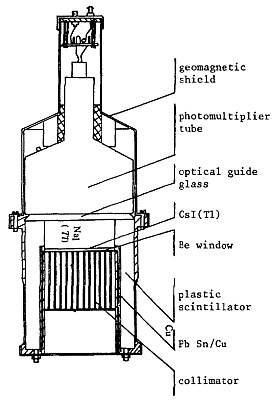Purpose of the flight and payload description
HAPI-1 was a Hard X-Ray phoswich balloon borne telescope developed in early 1980's decade at the Institute of High Energy Physics of the Chinese Academy of Sciences. The aim of the instrument was to observe high-energy celestial objects, such as pulsars and binary X-ray sources.
The structure of the telescope is shown in the figure at left (click to enlarge). The primary counter had an area of 145 cm2 and was composed of seven 5 cm x 0.5 cm Thallium doped Caesium Iodide CsI(T1) crystals, and a 0.5 mm thick Berilium slice used as incident window. A Thallium doped Sodium Iodide NaI(Tl) crystal of diameter 15 x 5 cm was placed at the back of the primary crystal to act as an anticoincidence shield. It effectively stopped the hard X-ray and gamma-ray background and reduced the effect of Compton scattering in the primary counter. The two kinds of crystals were optically coupled. Flourescence photons were viewed by a photomultiplier. A pulse shape discrimination circuit (PSD) was used to distinguish the two kinds of pulses with different fluorescent decay times. The shield cylinder of half opening angle 20º was composed of plastic scintillation material and Pb, Sn, Cu layers and was used as an anti-coincidence shield to charged particles. It stopped over 90% of hard X-ray background photons from the upper hemisphere while the Sn and Cu absorbed secondary background photons. Within the shield cylinder, twenty 1 mm thick copper slices, cross arranged, conformed a collimator that reduced the field of view to 4º (HWHM) and the effective area to 116 cm2. In the photon refugee shade of the photomultiplier, three layers of non-crystal alloy of high magnetic permeability, were used as lining to reduce the effect of the Earth's magnetic field on the properties of the photomultiplier. The observational range of the telescope was 20-200 keV.
The gondola that housed the telescope allowed to point the instrument both in azimuth and elevation. Azimuthal movement was driven by a magnetometer. Ground command caused the magnetometer to deviate through an angle relative to the gondola, the control system then rotated the gondola through the same angle in the opposite direction, until the magnetometer was in an equilibrium position. Elevation control was achieved driving directly a stepping motor. During flight, the gondola attitude control system was calibrated by pointing to the Sun. The stability of attitude control of the telescope system was about 0.1º and the pointing accuracy was better than 0.5º.
Signals from the primary detector, including the shaping pulses that reflected photons arrival time and the analog signals that contained amplitude information were immediately sent to ground through a two channel FM telemetry system. After demodulation, the information was then transferred to a computer-equipped data acquisition system on the ground.
Details of the balloon flight
Balloon launched on: 5/23/1984 at 7:39 local
Launch site: Xiang He Balloon Launch Center, Hebei, China
Balloon launched by: Institute of High Energy Physics (IHEP)
Balloon manufacturer/size/composition: Zero Pressure Balloon
End of flight (L for landing time, W for last contact, otherwise termination time): 5/23/1984
Balloon flight duration (F: time at float only, otherwise total flight time in d:days / h:hours or m:minutes - ): 8 h
The balloon was launched from the Xianghe balloon station in Hebei Province at 7:39am (Beijing time) on 23 May, 1984. After a nominal ascent phase, it reached a float stable altitude of 33 km. After 8 hours of flight, the connecting rope between the balloon and the gondola was cut on command from the ground and the apparatus was recovered.
External references
- A hard X-ray telescope and its observation of the Crab pulsar Chinese Astronomy and Astrophysics Volume 11, Issue 3, September 1987, Pages 179-185
- Observation of hard X-rays from the Crab pulsar and A0535+26 19th Intern. Cosmic Ray Conf., Vol. 1 p 149
5382If you consider this website interesting or useful, you can help me to keep it up and running with a small donation to cover the operational costs. Just the equivalent of the price of a cup of coffee helps a lot.


